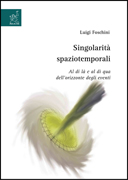Cern courier
Foschini presents a short history of physics to explain that the concept of something that inexorably traps everything was not introduced with Albert Einstein's general relativity theory. Instead, John Michell in 1783 computed the mass of an object that could trap light, by using Isaac Newton's gravitational formula and Ole Rí¸mer's discovery that the velocity of light, c, is non infinite and requires that the escape velocity be larger than the measured value of c. Foschini goes on to describe the work by Karl Schwarzschild that leads to the modern concept of black holes as singularities in the solution of Einstein's equations for a non-rotating spherical system in general relativity.His book Singolarità spaziotemporali has a twofold aim: it explains what space-time singularities are and what their observable effects are; and it provides the reader with an up-to-date picture of astrophysical research. In particular, one explicit purpose of the book is to educate the reader that "black holes" is a misnomer, and should be avoided, especially in scientific publications. Indeed, John Wheeler coined the name in the 1960s, before Stephen Hawking realized that they do emit radiation (though usually very faint), and therefore they are not really "black".The second half of the book focuses on the properties of active galactic nuclei and their classification. Here, the author describes aspects of research currently under study and emphasizes the importance of correlating measurements made using different techniques. In my opinion, this is the part that makes the book seem fresh and in some sense unique. Usually, books aimed at a broader public do not mention topics at the forefront of research. I appreciated that Foschini dared to do so.Although I am Italian, I think it a shame that the book is written in Italian, as it does not reach a large number of potential readers. In addition, it includes a few formulae, which is usually sufficient to discourage many people. The author explicitly states that there is a limit to simplification if one wants to avoid dangerous distortions of the concepts he is trying to explain. This is certainly true, but I think a few deeper explanations would have been helpful, thus avoiding the need to consult the references for further reading.
Link al sito









